Life, Liberty, Property #59: This economy does not look good; crime victimization is increasing, and officials are cracking down on protests.
by S.T. Karnick
IN THIS ISSUE:
- This Economy Does Not Look Good
- Crime Perceptions Versus Reality Versus Data
- Against the Speech Crackdown
- Cartoon
SUBSCRIBE to Life, Liberty & Property (it’s free). Read previous issues.
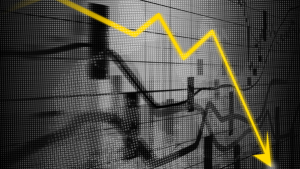 This Economy Does Not Look Good
This Economy Does Not Look Good
The latest economic numbers show a precarious economy suffering the cumulative effects of several years of bad economic policy.
Combined with intensifying social conflicts, individual pathologies, and demographic decline, this does not bode well for the nation’s stability and the people’s well-being.
GDP growth was 1.6 percent in the first quarter of the year, down from 3.4 percent in the fourth quarter of 2023 and 4.9 percent in the third quarter. The last three red bars of this graph show an ominous trend:

Source: The Wall Street Journal
Those forecasts for the rest of the year—represented by the gray bars—look overly optimistic in light of the slide from Q3 2023 to Q1 2024.
Very much so, in fact, given the economic fundamentals coinciding with that decline are still in place: record-high government spending and borrowing, major quantitative tightening and normalized interest rates by the Federal Reserve, decreases in the size of the American-born workforce (who are being replaced by immigrants), record-high credit card debt, very high housing costs (up by 37 percent since the first quarter of 2020 through the end of last year), and a record amount of federal regulation imposed on the nation’s businesses.
Meanwhile, core inflation was at 3.8 percent annual rate in the first quarter, the Commerce Department reported on Thursday. That was a greater increase than expected, with economists having forecast a 3.4 percent annual inflation rate for the quarter. Consumer spending and incomes rose at a 6 percent annual rate in March.
Core inflation rose at an annual rate of 2.8 percent in March. The big quarterly gain reported by the Commerce Department “was mostly the result of an upward revision to January’s monthly increase to 0.5% from 0.45%, says economist Paul Ashworth of Capital Economics,” USA Today reported.
That has been an interesting habit of the Biden administration: reporting lower inflation and unemployment to great fanfare and then revising the figures upward when nobody is listening because new, similarly incorrect and overly positive numbers are released for the next month or quarter.
The inflation numbers mean the Federal Reserve will not be easing up on the money supply in the next few months. It seemed that Fed Chairman Jerome Powell had been looking for any possible reason to start lowering interest rates, which would have been expected to help President Joe Biden’s reelection prospects by artificially stimulating the economy.
Biden is doing his very best to destroy his chances via economic brutality. The American Action Forum reports Biden administration “agencies published $875.3 billion in total costs and added 4.7 million annual paperwork burden hours” on the U.S. economy in just one week in mid-April, including tighter emission standards for cars, tougher efficiency standards for “general service lamps,” and silica exposure limits clearly meant to end coal mining.
That one-week regulatory bacchanal amounted to “[j]ust $20 billion less than what President Obama did in two terms!,” at an average cost of more than $1.5 billion per regulation, fully six times the Obama administration average of $250 million, wrote AAF President Douglas Holtz-Eakin in another article on the site.
The Biden administration has made Obama look comparatively lenient, and the contrast between Biden and Trump is ten times as dramatic as that:
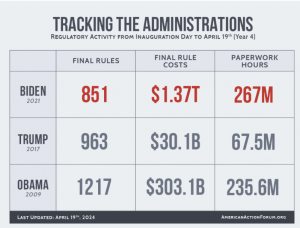
Source: American Action Forum
Holtz-Eakin describes this Biden mania as “simply a jaw-dropping regulatory record” and notes, “perhaps even more stunning is the radio silence it is receiving from the media. Regulations are taxes in another form. If President Biden had imposed $1.3 trillion in taxes by executive fiat, the media would be aflame.” Aflame with joy is what they would be, but Holtz-Eakin may be correct in suggesting that they would report on it.
The Biden administration is not stopping there by any means. The Federal Trade Commission issued a rule on Tuesday banning contracts that prevent employees from moving to rival companies, which apply to an estimated 30 million workers at present. On that same day, the Department of Labor increased the number of people who must be paid overtime for their work. Both of those moves will raise business costs and reduce productivity.
On Thursday, the Federal Communications Commission voted to reimpose net neutrality, which increases prices and reduces availability of broadband services. The Committee to Unleash Prosperity reports:
After the Obama FCC imposed Title II, broadband investment fell for the first time outside of a recession.
That changed after the Trump FCC scrapped the Obama rule. Investment and access to high-speed Internet surged. By the end of 2019, 94% of Americans had access to high-speed fixed and mobile broadband, up from 77% in 2015. In 2022 broadband builders laid more than 400,000 route miles of fiber, more than 50% more than in 2016.
Prices fell with more competition. A study by Casey Mulligan and Phil Kerpen for the Committee to Unleash Prosperity found that, from September 2017 to September 2023, the price index for wired internet services fell 11% compared to the overall consumer-price index. The CPI for wireless fell 21% in real terms. The biggest winners from this price decline were low-income households, which pay a higher share of their earnings on broadband.
State and local minimum wage increases are doing additional harm—raising prices without increasing output—while ever-tighter state and local land-use regulations are suppressing the production of new housing, the need for which is being exacerbated by mass immigration. Rising crime caused by reductions in law enforcement is creating havoc among retail businesses and causing many to close down or move to other jurisdictions, creating costs that would be unnecessary if governments were doing their job.
In addition to all that, Congress and the president enacted into law $95 billion in what is being called foreign aid, though most of it ($57 billion) is really aid to domestic U.S. manufacturers of weapons whose products will be sent to Ukraine, Israel, and Taiwan. That too is inflationary, though nowadays we are invited to feel that $95 billion is a pittance when it comes to government spending for causes deemed worthy by the Uniparty.
Meanwhile, the Biden administration’s refusal to guard the nation’s border is increasing the cost of government in localities across the country, especially those self-designated as sanctuary cities. Democrat mayors are screaming for more money from the Biden administration. Regardless of who ends up paying, the additional expense is another dead loss for the country.
With such a gargantuan burden on the nation’s productive people, private inventories and net exports were down in the first quarter, as was consumer spending on goods. Although “March new orders for durable goods were up a sharp 2.6% … , the overall trend in new orders remains flat to down in current dollars and down after inflation,” economist Robert Genetski wrote on Friday.
The big upward movement in the quarter was in spending on consumer services. It is difficult to believe that this resulted from great improvements in services having made them more precious to the consumer. On the contrary, it seems certain that it is all due to unnecessary cost increases caused by governments and the higher interest rates, which the businesses are forced to pass on to the consumer. The latter have been increasing their credit card debt to cover the price hikes.

Source: The Wall Street Journal
The rapid decline in GDP growth since last summer reflects real problems with the U.S. economy. These have been papered over by expansive federal borrowing, which has spurred consumer spending (and price and asset inflation):
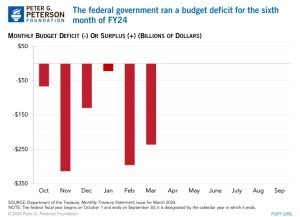
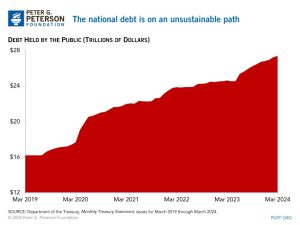
The borrowing is a result of massive federal spending increases, far above the January 2017 to January 2020 trendline:
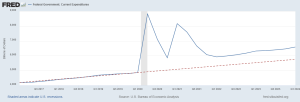
Spending has not come back down since the end of the pandemic, as Congress and Biden refuse to cut anything.
The spending increases have continued while per capita income has decreased and is far below the 2017 to January 2020 trendline:

After-tax income is even worse, because of the tax increases imposed by President Biden and congressional Democrats in 2021 and 2022:
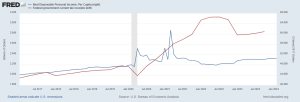
Biden now wants to double the capital gains tax, to 39.6 percent, and raise the payroll tax for Medicare to 5 percent from the current 3.8 percent, an increase of nearly one-third. Biden proposes also to raise the top income tax rate by 2.6 percentage points and place a minimum tax on billionaires. All of this will further suppress economic activity.
The markets have been hoping against hope that the Fed will declare inflation beaten and begin lowering interest rates to stimulate the economy. There is a strong case to be made that inflation is in fact already below the Fed’s 2 percent target. I agree with that assessment.
Interest rates, however, are not holding down economic growth. The real (inflation-adjusted) one-year rate is 2.01 percent, and the ten-year rate is 1.93 percent. Those are bearable and are certainly not anywhere near the rates of the Volcker years. The Fed’s ongoing quantitative tightening has possibly been unduly severe, but that is not the problem either, I believe.
The problem is federal overspending and the massive weight of government regulations on the economy. The American people cannot get anywhere near their potential production of goods and services when the federal government is doing so much to stop them and states and localities are piling on even more trouble.
The Fed will not be cutting interest rates soon, and it will continue its quantitative tightening. Much more damaging, however, is the federal government’s taxing, spending, borrowing, and regulatory policies. That will not change before January 20 of next year, if then.
It is sad to see such a great country brought so low. Americans have long been a very independent lot, and the recent campus protests can be seen as an indication that today’s young adults are as angry at the present state of things as the MAGA people, never-Trumpers, and unhappy Democrat rank and file are.
Anger is rising all around us. I wonder what will come of this.
Sources: USA Today; American Action Forum; Committee to Unleash Prosperity; Kiplinger; Heartland Daily News
 Crime Perceptions Versus Reality Versus Data
Crime Perceptions Versus Reality Versus Data
The U.S. media have been pushing the story that Americans are unduly worried about crime.
ABC News, in a rather fair story, set up the situation as follows:
In his State of the Union address this month, President Joe Biden boasted that the nation reported a historically low murder rate in 2023 and violent crime had plummeted to one of the lowest levels in 50 years.
For some Americans, however, the perception of crime is clashing with the statistics.
“I don’t believe it, plain and simple. I don’t believe it because we’re experiencing different results,” Auriol Sonia Morris—a South Carolina education, finance and legal consultant who describes herself as a Black conservative Republican and a supporter of former President Donald Trump—told ABC News.
Delving into the public policy implications from an anti-enforcement perspective, Vox argued “Lawmakers are overreacting to crime,” in a commentary last Thursday. “Crime rates are falling. Why are lawmakers passing tough-on-crime bills?” the secondary headline of the story asked. The question relies on the assumption that crime is going down. Is that true?
The FBI’s latest crime report shows a decrease in violent crimes, ABC News reported: “The FBI quarterly uniform crime report published on Tuesday indicates a widespread decrease in violent crime during 2023 compared to the previous year, as well as a 13% decline in homicides relative to 2022.”
The story quotes Robert Boyce, retired chief of detectives for the New York Police Department, as affirming “crime is down in the last couple of years.” Nonetheless, crime is up, Boyce told ABC News:
Boyce said while overall crime has fallen substantially in the past two years, it is still higher than it was in 2019 before homicides soared 30% in 2020 during the COVID-19 pandemic that shut down criminal courts and prompted a reduction in prison and jail populations throughout the country to curb the virus. It was also a time when the George Floyd police custody killing in Minnesota triggered protests and demands to defund police agencies.
“We were up 30,000 crimes [in New York City] in 2023 versus 2019. That’s substantial,” said Boyce.
The data confirm that, the story notes:
According to historical data from the Major Cities Chiefs Association, homicides and aggravated assaults nationwide are up 17% and 14% respectively from 2019.
“The drop in crime [between 2022 and 2023] is welcomed by everybody. It should be and the police departments are doing their job across the country,” Boyce said. “But the analytics are from last year, not from 2019, where they should be.”
A bigger problem is that the official statistics are almost certainly wrong and highly misleading, as I have reported before in this newsletter. Writing in The Wall Street Journal, economist and crime prevention expert John Lott notes that the FBI’s crime data are way off because they falsely assume that people do not change in their propensity to call the police when victimized by criminals:
While the rate of reported violent crime fell 2.1% between 2021 and 2022, the National Crime Victimization Survey shows that total violent crime—reported and nonreported—rose from 16.5 incidents to 23.5 per 1,000 people. Nonreported violent crime in 2022 exceeded the 2015-19 average by more than 17%.
The public’s perception of crime is in fact accurate, Lott says. The government’s claims are inaccurate, Lott writes:
Americans think crime is on the rise, but the media keep telling them they’re wrong. A Gallup survey last year found that 92% of Republicans and 58% of Democrats thought crime was increasing. A February Rasmussen Reports survey found that 61% of likely voters say violent crime in the U.S. is getting worse, while only 13% think it’s getting better. Journalists purport to refute this by citing official crime statistics showing a downward trend.
Americans aren’t mistaken. News reports fail to take into account that many victims aren’t reporting crimes to the police, especially since the pandemic.
The reason behind the FBI’s crime-decrease myth is that in addition to people not reporting crimes, governments are failing to do so, including the FBI itself:
The U.S. has two measures of crime. The Federal Bureau of Investigation’s Uniform Crime Reporting program counts the number of crimes reported to police every year. The Bureau of Justice Statistics, in its National Crime Victimization Survey, asks some 240,000 people a year whether they have been victims of a crime. The two measures have diverged since 2020: The FBI has been reporting less crime, while more people say they have been victims.
The divergence is due to several reasons. In 2022, 31% of police departments nationwide, including Los Angeles and New York, didn’t report crime data to the FBI. In addition, in cities from Baltimore to Nashville, Tenn., the FBI is undercounting crimes those jurisdictions reported.
Another reason crimes reported to the police are falling is that arrest rates are plummeting. If victims don’t believe criminals will be caught and punished, they won’t bother reporting them. According to the FBI, if you take the five years preceding Covid-19 (2015-19) and compare them with 2022, the percentage of violent crimes in all cities resulting in an arrest fell from 44% to 35%. Among cities with more than one million people (where violent crime disproportionately occurs), arrest rates over the same period plunged from 44% to 20%.
Almost no property crimes result in arrests now, much less convictions, making it somewhat silly for people even to bother reporting them, and even for violent crimes the arrest rate is very poor, Lott’s Crime Prevention Research Center (CPRC) notes:
During 2022 in cities with more than a million people, only 8.4% of all violent crimes (reported and unreported) and 1.4% of all property crimes resulted in an arrest. Not all those arrests resulted in charges.
Nationwide, “only 14.6% of violent crimes result in an arrest,” CPRC reports. CPRC’s graph illustrating the situation is scandalous even though it stops at 25 percent—the arrest rates would look far worse if the chart went up to 100 percent:
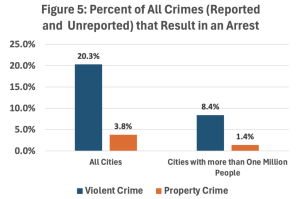
Fox45 News in Baltimore provided a good summary of the policy problem on April 9:
“As police solve fewer crimes, prosecutors convict fewer criminals, and even fewer offenders go to jail, victims lose faith that justice will be served—so they don’t bother report the crime & a real crime vanishes into thin air,” Sean Kennedy, the executive director of [Coalition for Law, Order and Safety], told The National Desk. It’s not that robbery is actually down, it’s that reported robberies are down. There’s a big difference.”
The coalition claimed politicization of the criminal justice system has contributed to what it perceived as the U.S.’s growing public safety crisis.
Reports from across the country confirm that crime is out of control in the United States. Here’s one from Chicago, where notoriously soft-on-crime District Attorney Kimberly M. Foxx stepped down after eight years of rampant crime, and Democrat primary voters replaced her with retired judge Eileen O’Neill Burke, whom The New York Times described as a moderate, for whatever that’s worth, in a very tight race with a Foxx-like progressive:
Eleven people standing outside a family gathering Saturday night were shot, including a young girl who was killed in what Chicago police believe was gang-related violence on the crime-ridden city’s South Side.
Four victims were children, police said Sunday. An 8-year-old girl was fatally shot, while a 1-year-old boy and a 8-year-old boy were each shot multiple times and listed in critical condition.
A 9-year-old boy was also injured with a graze wound to his finger and hospitalized.
No one was in custody Sunday afternoon.
Politique Republic posted a tart reply to the news of the purported gang attack:

From Indianapolis, Indiana on Thursday, reported by Fox59:
Police are responding to a deadly triple shooting at an apartment complex on the city’s near northwest side.
The Indianapolis Metropolitan Police Department said the shooting occurred shortly after 10 a.m. in the 3400 block of Timbersedge Drive in Wildwood Village Apartments. This apartment complex is located near 38th and Guion. …
Thus far this year, IMPD has investigated 150 non-fatal shooting incidents resulting in 183 victims.
“This complex is usually very quiet. We don’t see many problems. This is a good community,” said Officer Thomas Thompson.
This happened in a “very quiet” “good community,” you will note. People are not imagining this. Your local news will undoubtedly provide dismal further examples of the nation’s crime problem.
“Law enforcement has collapsed in the U.S., particularly in big cities,” and “many Americans [are] no longer confident that the legal system will protect them,” Lott writes.
The solution to the puzzle posed by soft-on-crime analysts is obvious. The American people are better at identifying crime than the FBI.
Sources: ABC News; The Wall Street Journal; Crime Prevention Research Center; Fox45 News, Baltimore; The Western Journal; Fox59 Indianapolis
 Against the Speech Crackdown
Against the Speech Crackdown
The student protesters gathering on college campuses across the country strike many observers as dangerous, uninformed, and unfocused. Conservatives have been prominent in calling for a major crackdown on these protests.
In Texas, Gov. Greg Abbott has exemplified this impulse with his aggressive actions against protestors who use language deemed antisemitic (I say “deemed” simply for accuracy, because there can be reasonable dispute over what constitutes antisemitic speech) in the wake of his March executive order “directing universities to change their free speech policies to properly punish antisemitic speech—a category state Republican leadership applies to criticism of the war in Gaza,” as The Hill describes it:
Police in riot gear broke up an unsanctioned but nonviolent demonstration at the state’s flagship university Wednesday.
Among those arrested was a journalist with the local Fox 7 news affiliate, who has been charged with criminal trespassing, according to the news organization.
Of course, the government should stop all violence, physical disruption, and disturbances of the public peace.
This is different. Abbott is directing the government of Texas to suppress speech based on its content.
The pivot away from protection of free speech is ill-advised, unprincipled, and unjustified.
It is ill-advised because free speech protects conservatives as well as their opponents. Conservatives, libertarians, and classical liberals need that protection much more than others, in fact, because the Left holds so much power in the nation’s institutions and uses it forcefully. Colleges and universities suffer from a lack of free speech, not an excess of it.
In addition, a government that can forcibly take away anti-Israel protestors’ speech rights can just as easily take away liberty-minded people’s right to speak. All it takes is one election for that power to be aimed at a different target.
The abandonment of support for free speech is unprincipled because it chooses what people can say in public, based on who has won the last election. We have had more than enough of that from the Left. A principled stand supports freedom of speech for all, not just those with whom we agree or whom elected officials deem not dangerous.
The difference between the Texas crackdown and the appalling injustices directed toward January 6 protestors is a matter of scale, not principle. (The difference in scale is enormous, to be sure.)
Finally, the push for limits on students’ speech is unjustified because this speech in itself poses no threat. If sensible people cannot refute these young individuals whom they see as uninformed and unfocused, then all is lost in any case. Personally, I find antisemitism to be reprehensible. If I and others like me cannot articulate persuasive reasons to draw that conclusion, it is our fault and no one else’s.
Pro-Palestine sentiments may mask antisemitism, and they may even be part of a rising generalized hatred of civilization (which I increasingly suspect to be the case). If so, defenders of civilization should charge into the breach and correct the record. Defenders of modern Israel should do likewise. May those with the truth on their side succeed.
That is how a well-functioning society operates.
Source: The Hill
Cartoon
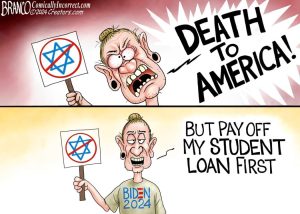
via Comically Incorrect
For more great content from Budget & Tax News. For more Rights, Justice, and Culture News.
For more from The Heartland Institute.











